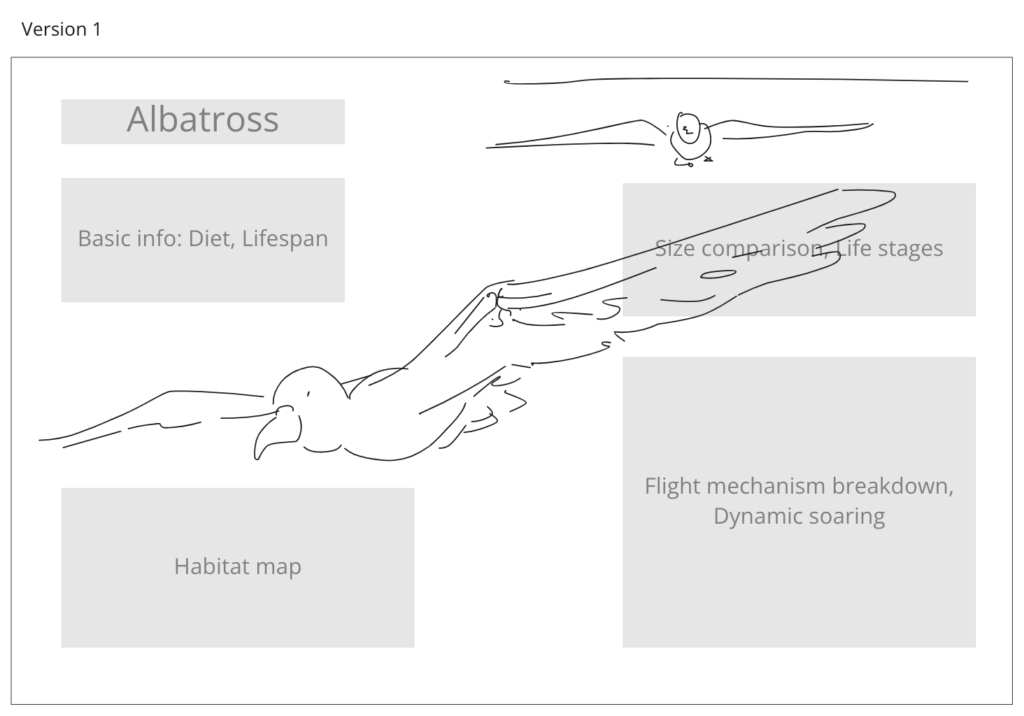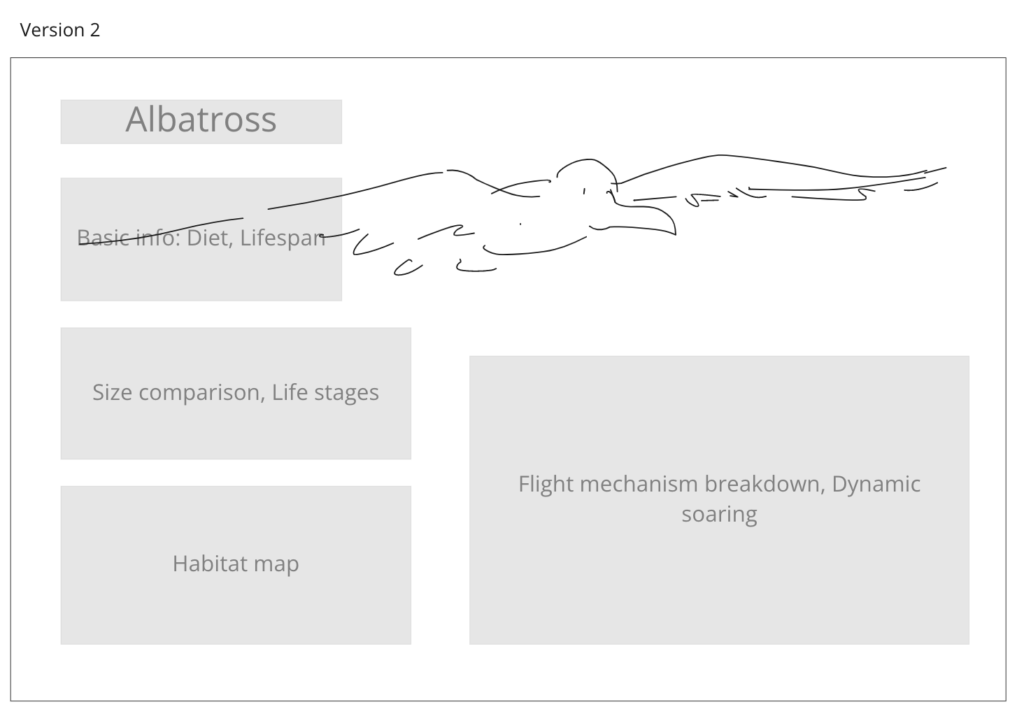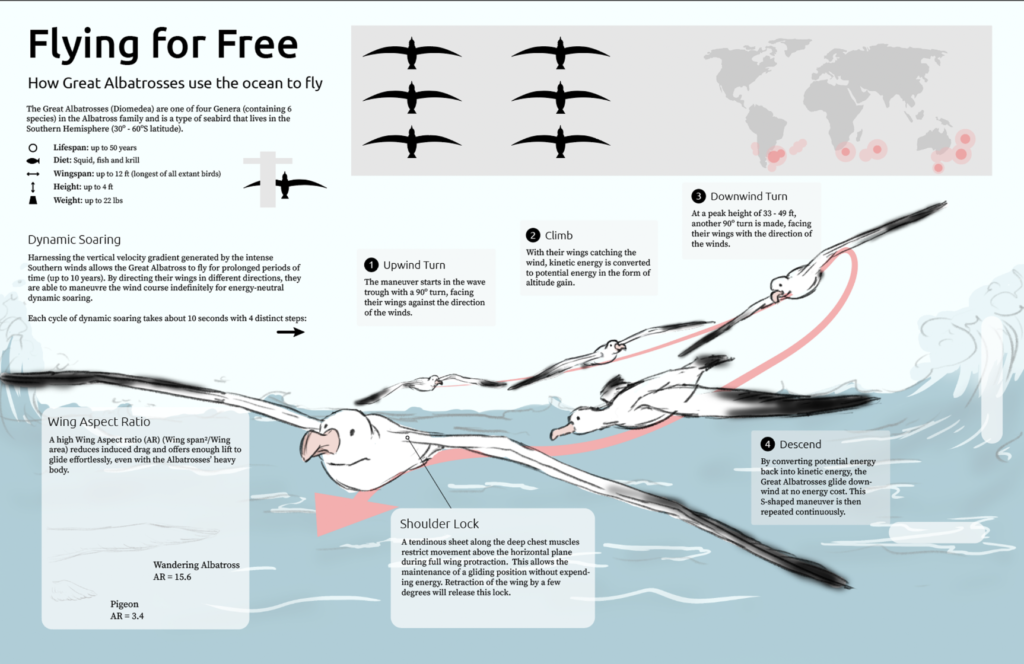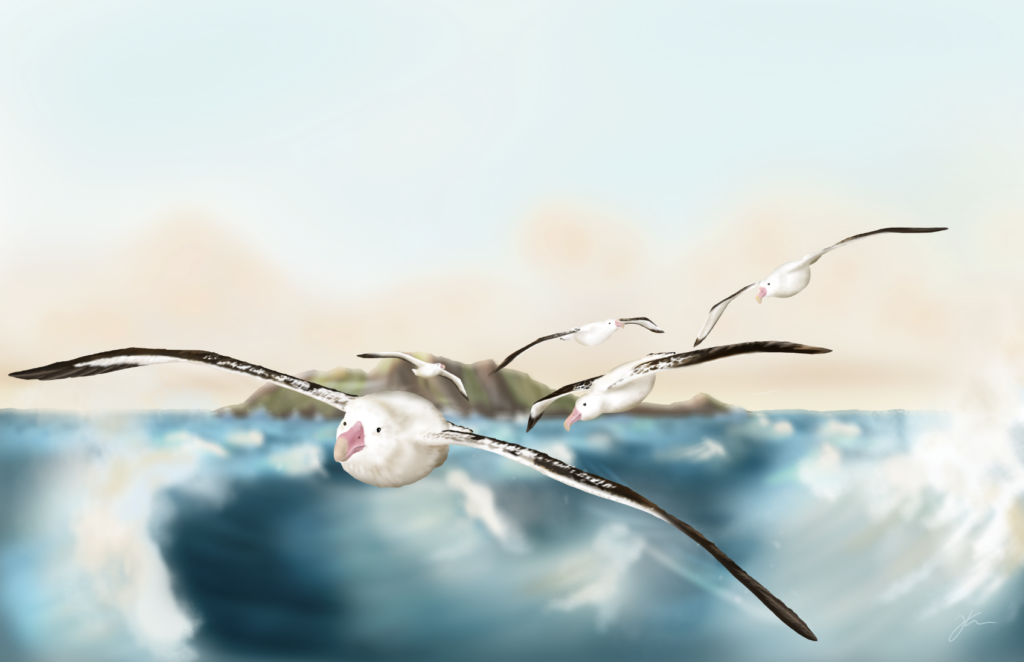
Flying for Free
How Albatross birds harness ocean winds
Infographic
Flying for Free
How Albatross birds harness ocean winds
Infographic
Challenge:
To explain the complex, motion of Dynamic Soaring through a static visualization.
Solution:
Illustrating the flight motion sequentially to mimic the flight path of the Albatross across the ocean. Then, using the wind gradient scale to explain the difference of velocities across different heights above sea level.
Tools
Miro, ZBrush, Adobe Photoshop, Adobe Illustrator
Client
Prof. Jodie Jenkinson (MSC2023H)
Target Audience
Undergraduate science students, avian enthusiasts
Challenge:
To explain the complex, motion of Dynamic Soaring through a static visualization.
Solution:
Illustrating the flight motion sequentially to mimic the flight path of the Albatross across the ocean. Then, using the wind gradient scale to explain the difference of velocities across different heights above sea level.
Tools
Miro, ZBrush, Adobe Photoshop, Adobe Illustrator
Client
Prof. Jodie Jenkinson (MSC2023H)
Target Audience
Undergraduate science students, avian enthusiasts
Process
Ideation
Due to the Albatross’ scarcity and remote habitat, not a lot of research has been done on their unique physical traits and how it contributes to their flight. To begin, a word map was created to brainstorm ideas. Then, literature research was conducted on the Albatross’ species, flight mechanics and bone structure.

Color and Layout




Maquettes
Starting from a sphere in ZBrush, rough albatross maquettes were created and laid out in its flight path.
Maquettes
Starting from a sphere in ZBrush, rough albatross maquettes were created and laid out in its flight path

Comprehensive Sketch and Render
Using the maquettes, comprehensive sketches of the final layout are created. Adobe Photoshop was used to render the scene which was compiled with the graphical elements that were created using Adobe Illustrator.





References
- AZ Animals. (2021, February 16). Wandering Albatross. AZ Animals. https://a-z-animals.com/animals/wandering-albatross/eBird. (n.d.). Wandering Albatross.
- eBird. Retrieved February 10, 2022 from https://ebird.org/species/wanalb/
- Gáspárdy, A. (2017). Connection among Body Measurements and Flying Speed of Racing Pigeon†. International Journal of Agricultural Science and Food Technology, 009–018. https://doi.org/10.17352/2455-815x.000016
- Meyers, R. A., & Stakebake, E. F. (2005). Anatomy and histochemistry of spread-wing posture in birds. 3. Immunohistochemistry of flight muscles and the “shoulder lock” in albatrosses. Journal of Morphology, 263(1), 12–29. https://doi.org/10.1002/jmor.10284
- National Geographic. (2018, October 18). Albatrosses’ Life-Long Bond Begins With Elaborate Courtship – Ep. 3 | Wildlife: Resurrection Island [Video]. Youtube. https://www.youtube.com/watch?v=LwwVnUekpeE
- Pennycuick, C. J. (1982). THE FLIGHT OF PETRELS AND ALBATROSSES (PROCELLARII FORMES), OBSERVED IN SOUTH GEORGIA AND ITS VICINITY. In Trans. R. Soc. Land. B (Vol. 300). https://royalsocietypublishing.org/
- Perez, C. R., Moye, J. K., & Pritsos, C. A. (2014). Estimating the surface area of birds: Using the homing pigeon (Columba livia) as a model. Biology Open, 3(6), 486–488. https://doi.org/10.1242/bio.20146999
- Phillips, R. A., Gales, R., Baker, G. B., Double, M. C., Favero, M., Quintana, F., Tasker, M. L., Weimerskirch, H., Uhart, M., & Wolfaardt, A. (2016). The conservation status and priorities for albatrosses and large petrels. In Biological Conservation (Vol. 201, pp. 169–183). Elsevier Ltd. https://doi.org/10.1016/j.biocon.2016.06.017
- Richardson, P. L. (2011). How do albatrosses fly around the world without flapping their wings? Progress in Oceanography, 88(1–4), 46–58. https://doi.org/10.1016/j.pocean.2010.08.001
- Richardson, P. L. (2015). Upwind dynamic soaring of albatrosses and UAVs. Progress in Oceanography, 130, 146–156. https://doi.org/10.1016/j.pocean.2014.11.002
- Richardson, P. L., Wakefield, E. D., & Phillips, R. A. (2018). Flight speed and performance of the wandering albatross with respect to wind. Movement Ecology, 6(1). https://doi.org/10.1186/s40462-018-0121-9
- Sachs, G., Traugott, J., Nesterova, A. P., Dell’Omo, G., Kümmeth, F., Heidrich, W., Vyssotski, A. L., & Bonadonna, F. (2012). Flying at No Mechanical Energy Cost: Disclosing the Secret of Wandering Albatrosses. PLoS ONE, 7(9). https://doi.org/10.1371/journal.pone.0041449
- Shaffer, S. A., Weimerskirch, H., Costa, D. P., & Weimerskirchi, H. (2001). Functional Significance of Sexual Dimorphism in Wandering Albatrosses, Diomedea exulans. In Functional Ecology (Vol. 15, Issue 2).
- Sranko, G. (n.d.). How Long Can an Albatross Fly? (Do Albatrosses Sleep While Flying?). BioGeoPlanet. Retrieved February 10, 2022 from https://biogeoplanet.com/albatross-flight-dynamic-soaring/
- Warham, J. (1977). Wing loadings, wing shapes, and flight capabilities of procellariiformes. New Zealand Journal of Zoology, 4(1), 73–83. https://doi.org/10.1080/03014223.1977.9517938